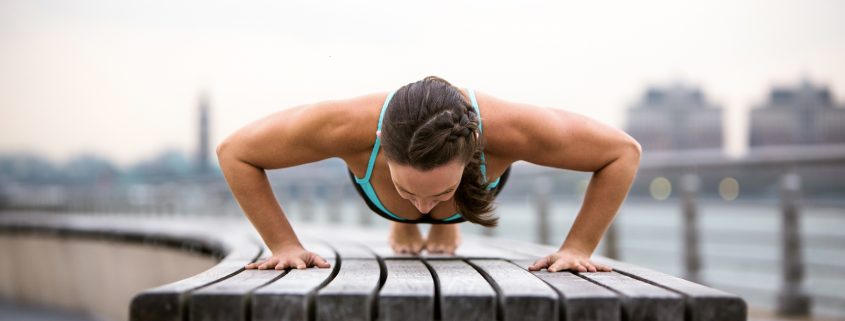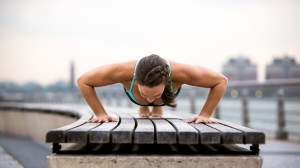Simple Form Fixes that can Prevent Injury and Increase Results
When people ask me about excellent trainers in the city, Brooke Marrone comes to mind over and over. Brooke has a huge roster of private clients in the city, and she is incredibly thoughtful in her approach to each person. She is exceptionally good at addressing injury and is known for her injury-prevention expertise.
Like Brooke, I am also obsessed with injury-prevention. I felt like a great way to approach injury prevention in my blog was to ask Brooke for her thoughts on the best ways to execute some basic exercises more safely and effectively. You’ll see many versions of these exercises in my own classes and in many others across the city. Hopefully Brooke’s suggestions will help you approach them with more knowledge and care – and will help you get the most out of your overall fitness routines, wherever you go.
Enjoy!
~Mahri
******************************************
Simple form fixes that can prevent injury and increase results
– by Brooke Marrone
Proper form is vital to staying injury-free and keeping your body fit – not just for right now but for the rest of your life. Working hard will not get you as far if you’re not working intelligently. Some of the most basic exercises are often the ones most commonly done wrong.
Here are some simple form fixes that can help prevent injury and allow you to get the most out of your fitness routine.
Lunges:
One of the best ways to tone your lower body. I am a big fan of both the front and back lunge. A proper lunge engages everything from your glutes, quads, and hamstrings to your core. It increases hip flexibility and can also improve your balance. Unfortunately, when done wrong, the knees, neck and low back can sustain unnecessary stress. Try doing a set in front of the mirror or with a friend to see if you are doing the exercise correctly.
- Think 90-degree angles! Step forward or back with one leg, lowering your hips until both knees are bent at about 90 degrees
- Make sure that you look forward, keeping your shoulders back and abs pulled in while maintaining a straight spine
- In a front lunge, make sure not to lean your upper body forward. This causes the front knee to go beyond the toes and puts strain on your knee, low back and neck. While performing a back lunge, follow a similar protocol. Make sure you step back far enough to allow your hips to get a proper stretch and avoid straining the knee
Tricep Dips:
Tricep dips are a great way to work your triceps that you can do just about anywhere! Common mistakes with the tricep dip include bending the elbows beyond a 90-degree angle and also bending the elbows out to the side rather than behind the body. Doing this puts strain on your elbows, causes your shoulders to rotate forward, and ultimately takes the work away from the muscles you are targeting.
- Place your hands shoulder-width apart on a chair or bench
- Extend your legs out in front of you with both feet on the floor (or if more advanced, with the legs out straight)
- Slide your butt slightly off the chair, slowly bending your elbows to about a 90-degree angle. Keep your shoulders down and back throughout the exercise, and make sure to keep your elbows straight back instead of angling out to the side
- Straighten your elbows, and return to the starting position. If you have trouble maintaining proper form, begin with a more shallow angle and work your way into the 90-degree bend
Planks:
My favorite exercise! Planks are one of the most effective ways to strengthen your core, and they can also help reduce back pain when done properly. The most common mistakes include shifting your body weight forward, putting too much work on your already overworked shoulders, keeping your hips too high or too low, and bringing your elbows too wide (which puts a great deal of stress on your rotator cuff muscles).
- Think belly button to spine! Make sure to always keep a straight line from your head to your toes
- Keep your elbows directly under your shoulders with your weight shifted out of your neck and back into your heels
- Keep your legs strong and straight with your head a natural extension of your spine
- Form first always! Work your way into your plank starting with 30 seconds and gradually increasing your time as you become stronger
* One of my favorite tricks is the water bottle plank. Have a friend place a water bottle on your low back in line with your spine. If you keep the bottle from falling you are most likely maintaining proper form.
Push-Ups:
I am not sure how this rumor got started, but it’s widely believed that a proper push up means that you need to get your body as close as you can to the floor… period. The truth is that a proper push-up involves going as close to the floor as you can WHILE MAINTAINING GOOD FORM. Push-ups are meant to work your chest, shoulders, triceps and core. They are not meant to hurt your neck, low back and shoulders. Push-ups can be an amazingly effective exercise to tone your upper body, but they can also do serious damage when done wrong.
- Work your way into your perfect push-up, and begin on your knees if you need to. Start by going a few inches towards the floor while maintaining proper form until you feel strong enough to go a little further
- Remember when the kid from Jerry Maguire said the human head weights 8 lbs? Well you don’t need those 8 lbs stressing your low back! Make sure you keep your body in a straight line for the duration of your push up
- Similar to the plank, you want to make sure that you don’t drop your hips or pop them too high up to the sky. Sagging your hips will stop working your core and will directly stress your low back. Popping your hips will take the work out of your core and will put too much strain on your shoulders. In a proper push up, your weight should be evenly distributed
- Make sure to keep your hands slightly wider than your shoulders right outside your chest, keeping your shoulders down and back
- Inhale as you go down, and exhale as you come back up
******************************
Brooke Marrone launched her highly regarded private training studio in 2008. She is known for creating unconventional fitness programs that are fun and manageable. In fact, Vogue.com has noted that Brooke can “cure gym junkies of treadmill addiction.” Brooke has an extensive knowledge of musculoskeletal health and injury prevention. She collaborates with New York City’s top physical therapists to develop sustainable systematic approaches that allow her to train clients recovering from injuries that would otherwise impede the ability for exercise. Brooke also “understands how to keep clients from injuring themselves while encouraging them to do more than they ever thought possible.”
Brooke hails from Worcester, Massachusetts. She was a three sport Varsity athlete, played Division 1 NCAA field hockey at the University of Rhode Island, and served as a group instructor at Arizona State University. She also trained under one of Boston’s most acclaimed personal trainers. Brooke’s certifications include Personal Training, Pilates and Group Fitness.






Leave a Reply
Want to join the discussion?Feel free to contribute!